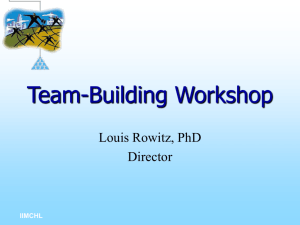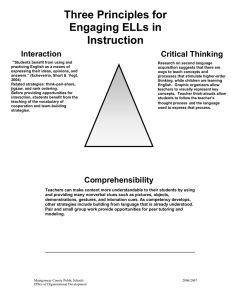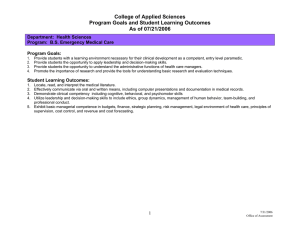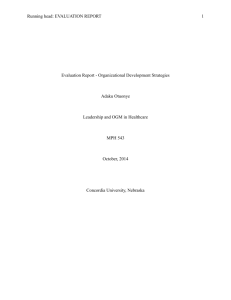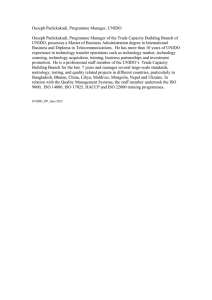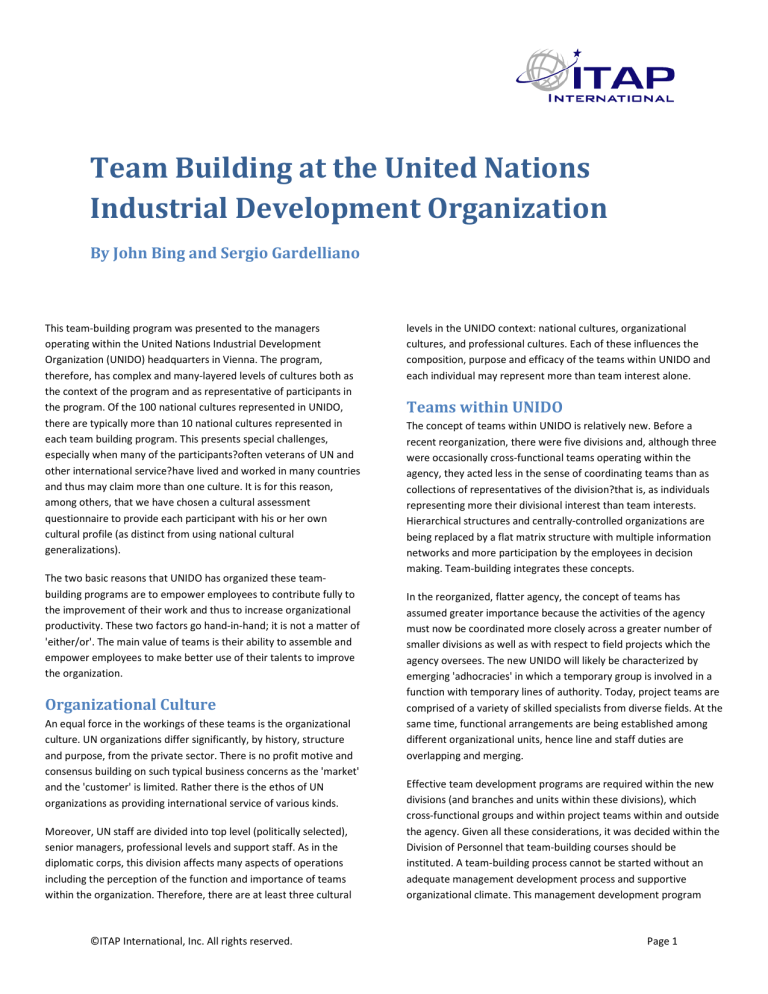
Team Building at the United Nations Industrial Development Organization By John Bing and Sergio Gardelliano This team-building program was presented to the managers operating within the United Nations Industrial Development Organization (UNIDO) headquarters in Vienna. The program, therefore, has complex and many-layered levels of cultures both as the context of the program and as representative of participants in the program. Of the 100 national cultures represented in UNIDO, there are typically more than 10 national cultures represented in each team building program. This presents special challenges, especially when many of the participants?often veterans of UN and other international service?have lived and worked in many countries and thus may claim more than one culture. It is for this reason, among others, that we have chosen a cultural assessment questionnaire to provide each participant with his or her own cultural profile (as distinct from using national cultural generalizations). The two basic reasons that UNIDO has organized these teambuilding programs are to empower employees to contribute fully to the improvement of their work and thus to increase organizational productivity. These two factors go hand-in-hand; it is not a matter of 'either/or'. The main value of teams is their ability to assemble and empower employees to make better use of their talents to improve the organization. Organizational Culture An equal force in the workings of these teams is the organizational culture. UN organizations differ significantly, by history, structure and purpose, from the private sector. There is no profit motive and consensus building on such typical business concerns as the 'market' and the 'customer' is limited. Rather there is the ethos of UN organizations as providing international service of various kinds. Moreover, UN staff are divided into top level (politically selected), senior managers, professional levels and support staff. As in the diplomatic corps, this division affects many aspects of operations including the perception of the function and importance of teams within the organization. Therefore, there are at least three cultural ©ITAP International, Inc. All rights reserved. levels in the UNIDO context: national cultures, organizational cultures, and professional cultures. Each of these influences the composition, purpose and efficacy of the teams within UNIDO and each individual may represent more than team interest alone. Teams within UNIDO The concept of teams within UNIDO is relatively new. Before a recent reorganization, there were five divisions and, although three were occasionally cross-functional teams operating within the agency, they acted less in the sense of coordinating teams than as collections of representatives of the division?that is, as individuals representing more their divisional interest than team interests. Hierarchical structures and centrally-controlled organizations are being replaced by a flat matrix structure with multiple information networks and more participation by the employees in decision making. Team-building integrates these concepts. In the reorganized, flatter agency, the concept of teams has assumed greater importance because the activities of the agency must now be coordinated more closely across a greater number of smaller divisions as well as with respect to field projects which the agency oversees. The new UNIDO will likely be characterized by emerging 'adhocracies' in which a temporary group is involved in a function with temporary lines of authority. Today, project teams are comprised of a variety of skilled specialists from diverse fields. At the same time, functional arrangements are being established among different organizational units, hence line and staff duties are overlapping and merging. Effective team development programs are required within the new divisions (and branches and units within these divisions), which cross-functional groups and within project teams within and outside the agency. Given all these considerations, it was decided within the Division of Personnel that team-building courses should be instituted. A team-building process cannot be started without an adequate management development process and supportive organizational climate. This management development program Page 1 must have the full support of senior managers; without their commitment, the teambuilding process would fail. The model we present is itself an important component of the management development strategy. It integrates many management/organizational concepts and enhances cultural synergy, which is essential for effective management practices in the kind of multicultural environment found in UN agencies¹. Program Design and Development The goal of developing and implementing a team-building program at the United Nations Industrial Development Organization is to improve overall organizational performance at a time of restructuring. The program has been designed to help participants visualize the interrelation of the main components of a teamperformance improvement process, namely the phases of team development and the four factors influencing team performance: individual differences, cultural factors, organizational context and environmental factors. • • • • • are there. If this question is unsolved, team processes will lead to disorientation, uncertainty and fear which is not the appropriate condition from which to enter into the next phase. Trust building During the second phase, members are engaged in sharing their expectations, competences and hopes with other participants, thus building the basic trust and rapport needed for effective communication. Goal clarification Phase three emphasizes discussion of team and individual priorities among members. Additionally, members' roles are clarified and the task to be undertaken is identified. Decision making At this phase decisions are taken by participants as to how the team will be managing resources, time, work processes, constraints, etc. Implementation During phase five, the members actually begin to sequence their work according to a time schedule and a shared vision. If the team was able to resolve the key questions of the preceding stages, a higher level of performance can be expected. Renewal This is the final stage, in which the team members look back and reflect on what they have achieved, work on their shortcomings and prepare themselves for the future. Each of these phase of team development is an essential part of the integrative model of team performance and is influenced by the organizational context, cultural factors and individual differences. Now we will examine each of these main areas of influence separately. Organizational Context What outside factors influence the capability of the team to achieve goals? This short question makes relevant the need to analyze how the organizational context affects team performance. The following factors are considered: One of the main components to consider while creating and sustaining high performance teams is the team development process. The six basic phases we utilize were identified by Drexler, Sibbet and Forrester (1988) and are always present in a team; however, each of them comes into focus at a particular stage. A team that resolves the questions of each phase and builds the next phase over the last one is better prepared for a higher level of performance. Unresolved questions in each phase will diminish the level of team performance, making the team increasingly ineffective. A brief description of each phase follows. • Orientation In this phase a certain ambiguity exists in the minds of the team members as to the purpose of their coming together. They need a clear answer to why they ©ITAP International, Inc. All rights reserved. Leadership The type of leadership and its effectiveness needs to be examined, which includes leadership within the team and within the organization and leadership styles which contribute to effective or ineffective management practices. Consideration was also given to situational and principle-centered leadership and its relationship with followership and strengths and weaknesses of the organization's leadership norms. Purpose Every team needs a clear mission. Determination of the purpose of the organization or division results from the negotiation process between 'What we want to do' and 'What we have to do'. Goals of Page 2 the team and purpose of the organization or organizational units could also require some adjustment. Structure It is important to analyze the organizational structure and its impact on group work and team performance. Structure is supposed to solve division of labor problems, not create them. Three main ways to organize are by • • • Cultural Factors Increased awareness about the nature and effects of cultural differences can overcome barriers to adjustment and peak performance within the team. The participants analyze their own cultural profile using the following dimensions from Fons Trompenaars²'s schema. This analysis focuses on cultural factors rather than professional or other issues. • function; product, program or project; or a mixture of both. An assessment should be carried out to determine the fit of team members' roles within the organizational structure. • Rewards Formal reward systems are no guarantee that staff will act in the way the system is attempting to prompt them. Formal or informal rewards should satisfy team members' needs, i.e. professional growth, esteem, acceptance, safety. Motivational or hygienic factors should also be considered, such as achievement, responsibility, team recognition and working climate. The strengths and weaknesses of the reward systems should be evaluated to determine if the system properly reinforces team goals and behaviors. Helpful Mechanisms Mechanisms are needed to help people in working together more effectively. Mechanisms are helpful when they assist in the coordination or integration of work or assist people in keeping track of whether things are going well or badly. Examples include management informational systems, performance appraisals, weekly problem-solving meetings and ad hoc brainstorming sessions. Relationships This analysis is centered in the relationships: (a) among people, peers or manager-subordinates; (b) between organizational units and tasks performed; and (c) between people, systems and technology. It is important to explore how these relationships affect team performance. The quality of relationships and their interdependence are highlighted. (This area dovetails with the analysis in the section on cultural factors.) The relation with the external environment of the organization is also explored. ©ITAP International, Inc. All rights reserved. • Relationships with people - Participants explore ways in which they relate to each other. For example, some may feel that friendship has special obligations and should come first in working relationships, while others may give more emphasis to following rules first and less importance to helping friends. Attitudes towards time - Individual team members may have differences relating to how strongly they are orientated to the influence of the past (for example, the importance of precedence and history), the present (for example, current organizational politics and concerns) and the future (for example, a vision for future development). Attitudes towards nature - Some people view the environment, fate and current circumstances as acting powerfully on individuals and will seek to live in harmony with these factors. Others may want to manipulate, control and even exploit the environment. These views may lead to very different ways of analyzing the feasibility and importance of projects. These attitudes are also highly important in anticipating reactions to field projects. The analysis of culture differences using a cultural profile questionnaire first helps participants understand how they may be perceived by others and, second, helps them to modify and expand their understanding of the behaviors of others. Cultural differences can either inhibit or augment the effectiveness of teams, depending in part on the awareness that each member brings to the team regarding these differences. If members view such differences as annoyances or barriers, then the team's effectiveness will be inhibited. If, on the other hand, members see these differences as representing alternative ways of both understanding and implementing the work of the team, the capacity of the team will be enhanced. Since there are within all cultures both effective and difficult (counterproductive) people, it is not the presence of individuals from multiple cultural backgrounds that causes problems but rather the presence of those who are either unwilling or unable to carry out the work of the group. This is an important distinction, since it is often assumed that the cultures themselves may inhibit the work of the team. Page 3 Recent research has suggested that although diverse teams take more time to complete tasks in the short run, in the long run they find more creative solutions. 2. Individual Differences In the analysis of individual differences, participants explore their personality type and reflect upon their working styles and management preferences. With the help of the Myers-Briggs Type Indicator³, participants gain a perspective on how they are energized, acquire information, make decisions and relate to their fellow workers. Within the context of these four scales they are helped to understand themselves and their behaviors and appreciate others, so as to make constructive use of individual differences. By knowing their own preferences and learning about those of others, they come to know their special strengths and how people with different preferences can relate to each other and become valuable within teams. Additionally, using the Myers-Briggs Type Indicator, the weighting of types within the team as a whole is analyzed and discussed with participants, with regard to the impact on the team as a whole and on the larger organization. In the present format of this teambuilding workshop, the individual differences resulting from technical competences or knowledge and experience levels are not analyzed. However, we believe that in the initial formation of teams, professional competences and complementary expertise should also be taken into consideration. 3. 4. 5. 6. Prerequisites for Development of the UNIDO Cross-Cultural Team-Building Program Training in team-building is an important component of the UNIDO Management Development Program and integrates skills developed in other management training modules, such as 'Interpersonal/Intercultural Skills Development' and 'Leadership Styles and Effective Management'. Before team-building sessions are conducted it has been found to be advisable to create a positive atmosphere in which such sessions can be conducted effectively. The following activities can be useful in building receptiveness. 1. It is necessary for participants to have participated in a primary workshop on intercultural skills development prior to attending the team-building program. This workshop provides participants with analytical tools to distinguish between different causes of management behavior; assess how their own cultural management preferences may affect the workplace environment; develop skills and strategies for working effectively in a multicultural, gender ©ITAP International, Inc. All rights reserved. neutral environment; and increase their awareness of research in the field of intercultural and gender management practices. Prior to the team-building program, team members should be selected or trained for the knowledge, information and expertise needed to help the overall group with its mission and should display competence in managing small- or large-scale projects. This involves skills in the areas of time management, negotiation, conflict management, presentation and intercultural communication. Team members should attend the course: 'Leadership Styles and Effective Management', during which participants reflect on how job performance and managerial effectiveness are related to the way they think about themselves and others. This workshop provides middle-level professionals and senior managers with the opportunity to examine their working styles as leaders, as well as the processes of managerial change and selfimprovement. One of the facilitators may meet with a group before it begins the team-building process to do a thorough needs assessment and inform the group of the structure of the program. Team input sessions are arranged with an organizational development practitioner to provide education in group decision making, communication, problem solving and skills of interfacing with other teams. Team sessions are held on forecasting, budget planning, member replacement and impact of technological or organizational changed on the team. Ground Rules During the Program In order to create a positive attitude towards the training program, the following guidelines are offered: 1. 2. 3. Group participation and consensus building should be encouraged. Group communication should have a specific content focus. Disagreements should be permitted, while effective listening should be considered a valuable asset. Constructive criticism should be encouraged. The members should also be assisted in expressing their feelings, clarifying their roles, and discussing relationships, assignments and responsibilities. There should be sharing of leadership functions and utilization of total member resources. From time to time there should be a re-evaluation of team progress and communication. Team members should be sensitive to the team's linking function with other work units. The whole approach of the team should be goal directed, fair in dividing the work and aimed at synchronization of efforts. Page 4 4. In order to implement the integrative model for crosscultural effectiveness, there are short lectures, assessment tools, group discussion and group work. The target group for the cross-cultural workshops can be professional staff, general service staff (administrative support staff) or a mixture of both. The Role of the Facilitator The facilitators (also the authors) are the chief, staff development and training section of UNIDO and the head of an outside training organization (ITAP International). The principle that has been used here is that an inside facilitator brings to program development and implementation an understanding of the organization. An outside facilitator brings new ideas, approaches and the insight of someone freed from local politics. Of course, both of these virtues are shaded by their opposites: the inside facilitator may have his or her own limitations within the training program itself; and the outside facilitator may not be interested in risk taking, in order to perpetuate his or her position as a consultant. These are the risks that any such 'inside?outside' endeavor brings. However, one has only to consider the limitations of two inside facilitators, or two outside ones, to understand the advantages of mixed roles. Equally advantageous in a course on cross-cultural areas is to use facilitators with different cultural backgrounds. One of the facilitators is of Argentinean?Italian background; the other is German?American. Given this mixture, the facilitators have the opportunity, in miniature, to demonstrate an effective multicultural team. Facilitators from only one cultural background with prima facie be unable to model a multicultural team. In these ways a sense of rapport and trust can be built with the participants. There are many other factors, of course, which contribute to rapport and trust but, in the case of cross-cultural team-building, these stand out. Opportunities and Obstacles Courses in the UN system are generally taught in English, and this was the language of the course. Because English is native only to a minority of participants, it is necessary to rethink exercises and presentations to allow for alternative ways of presenting ideas and facilitating communications within the groups. Methods include presenting materials in written as well as in spoken form and the use of overhead projections to convey ideas more through graphics than by words. Experienced facilitators also often use alternative words and phrases to describe the same phenomenon, making use of repetition. The problems and obstacles that have arisen in the program are both internal and external in nature. Over the course of the ©ITAP International, Inc. All rights reserved. development of this program, from its pilot state to its present form, the interrelationship between internal and external problems has been complex. Early in the pilot process, one of the programs was in the final 10 minutes when one of the participants re-entered the training room after a lengthy absence complaining that he had just heard that some staff would lose their jobs due to financial constraints. The reader can only imagine the effect of this emotional pronouncement on the rest of the group. (At that time there were three trainers, one of whom observed: 'This is a learning opportunity!') Problems can arise because of stresses within the organization itself, which cannot be banished from the classroom. On the contrary, in later courses, the facilitators have used the issues which cause their stresses as examples and discussion points within the program itself. Thus, the real institutional issues become the stuff of the course itself, strengthening both the course and the participants as well. The results of the team-building courses to date indicate the programs are exciting more interest than before as participants leave with both theoretical and practical approaches to strengthening teams of which they are a part. A recent exercise which required the participants to negotiate their team cultures, based on the Trompenaars's model, is an example. One team member noted that the teams started their negotiations from significantly different cultural positions, and they had had to learn each others' preferred style before they could go on to resolve these. What were once perceived as academic issues suddenly become real ones as the participants debated what type of decisionmaking style to use and what qualities were associated with successful team members. Let us take one example from a team culture questionnaire: 'Should team members (a) Make decisions together with reference to UNIDO's processes? (b) Leave some decisions to individuals, the rest to the team? (c) Leave decision to each member to decide?' This question brought individualistic team members up against group-oriented members. To develop their team culture, they had to learn both what their teammates preferred and how the context helped to define the appropriate course. The principal challenge for the authors is to understand how team issues are embedded in a forcefield that includes organizational culture and issues, individual (as opposed to cultural) preferences and larger environmental forces, such as changes in the UN system itself. Teams are composed of individuals with different preferences, based on their different cultures, and who are also strongly influenced by current organizational and environmental characteristics. For training to be effective, analytical tools must be Page 5 provided to team members to utilize in their daily work, and practice given in how to forge a team in the face of differences and difficulties. Conclusion and General Recommendations Since effective working arrangements across departmental functional lines are difficult to introduce in multicultural and intergovernmental organizations, management and human resources development specialists have a responsibility to lay the ground work for cross-boundary collaboration. Top management must provide the institution with an effective team model and a rationale for team work. Top-level commitment is essential. Without such commitment, teams which could be established at middle levels within the organization may fall apart because of lack of effective, supportive teamwork in other parts of organization. The training and development group must help to develop this model and convey its rationale to the staff of the organization by providing skill-building opportunities. Equally important, reward systems must be revised to acknowledge the contributions of individuals to overall team efforts. In order to develop specific skill sets in the organization's managers, we strongly recommend that professionals and administrative staff attend an initial workshop on 'intercultural and interpersonal skills development'. Team-building workshops should be conducted with staff at all levels. The aim of these team-building workshops should be to help participants define their performance and effectiveness and to establish norms of team development and support within groups within the organization. Follow-up workshops should be conducted to review what the participants have learned and how much they have incorporated their new skills into their daily working lives. It is also advisable to follow up in situ the performance of specific teams by analyzing the change in quality and quantity of their outputs. In a recent keynote address to the Society for International Education, Training & Research, Nancy J. Adler, Professor of Management at McGill University noted that transnational organizations develop through negotiated cultures: 'The United Nations ... is definitely not transnational, but rather quintessentially a multi-domestic organization'. In other words, the United Nations, and by inference its specialized agencies, has not yet developed its own culture from within, from negotiations and reconciliation of cultural values among those that work within its structures. ©ITAP International, Inc. All rights reserved. We realize that UN system is in the process of creating a new organizational culture, one which reflects the enormous changes that have occurred in the recent past in relationships between states throughout the world. Therefore, we believe that programs such as this one, which teach the skills of team development in a multicultural context, can reinforce a positive process to lead UN managers toward transnational operations in which each specialized agency can develop its own unique approach towards solutions of their related issues. We are also aware that in order to take root, such approaches must be supported by upper management and?ultimately?by the countries' representatives which comprise the boards of these organizations. This article originally appeared as chapter 7, pp. 103-114, of the book Cross-Cultural Team Building: Guidelines for more effective communication and negotiation, 1996, Mel Berger, Series Editor, McGraw-Hill UK. The views expressed here are those of the authors and do not necessarily reflect the views of the United Nations Industrial Development Organization. Notes ¹ The authors are indebted to the pioneering work of Marvin R. Weisbord. For more information on this analysis of organizational context, see Weisbord, Organizational Diagnosis: A Workbook of theory and Practice. Addison-Wesley, Reading, MA: 1978, repr. 1992. ² Fons Trompenaars (1993). The cultural profile questionnaire utilized in this program was developed by Trompenaars through his Center for International Business Studies (CIBS) in Amsterdam. ³ Myers-Briggs, I. (1996) Introduction to Type. A Guide to Understanding Your Results on the Myers-Briggs Type Indicator, 5th edn, Consulting Psychologist' Press, Palo Alto, CA. References and Further Reading Drexler, Allan B., David Sibbet and H. Forrester (1988) The Team Performance Model, NTL Institute for Applied Behavioral Science. Trompenaars, Fons (1993) Riding the Waves of Culture: Understanding Cultural Diversity in Business, The Economist Books, London. Weisbord, Marvin R. (1978, repr. 1992) Organizational Diagnosis: A Workbook of theory and Practice, Addison-Wesley, Reading, MA. Page 6
